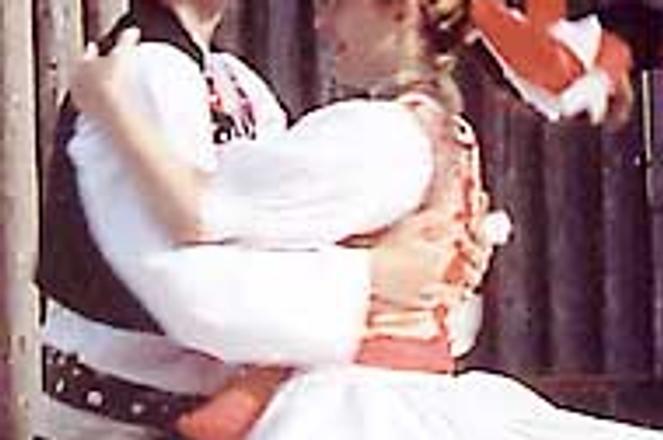TWISTING dances are the Slovak standard.photo: Courtesy of Východná festival
"WE ARE a small country but we have very diverse folk traditions. You just have to walk over a hill to find something different," says Jozef Burič, director of the Východná Folklore Festival that opens over the July 5 to 7 weekend in northern Slovakia's mountainous Liptov region.
Named after a small Liptov town, the Východná festival showcases traditional Slovak folklore through dances, songs and enacted customs. Founded almost half a century ago as a local festival, it has assumed nationwide significance, and now hosts foreign folklore ensembles as well. In three days 1,400 participants from across Slovakia as well as Georgia, Croatia, Romania and Hungary will share a large wooden stage at a local amphitheatre.
"Východná is one of the largest festivals in the country. It presents the best of Slovak folklore in a very authentic way," says Burič, adding that the winners of recent local folklore competitions make up the core of the festival.
Festival participants and visitors will be welcomed in a traditional way - with bread and salt - on July 5 at 21:00, although the stage will be occupied beginning at 13:00 by Liptov region folklore groups. At 21:45, the largest and best-known Slovak ensemble, Lúčnica, will hold a two-hour performance in honour of the birthday of its lifelong choreographer, Štefan Nosáľ. With the free entertainment continuing until midnight, the stage will be silent only during the early morning hours over the following two days.
"Occasionally two groups will even dance simultaneously to the same music, although their steps will be different," promises Burič.
From west to east and north to south, in each of Slovakia's 79 districts, folklore groups and ensembles struggle to keep alive local traditions which often vary from village to village. The country counts some 420 such groups as well as over 500 children's folklore groups.
Just as Slovakia's richly embroidered traditional clothes, seasonal customs and songs vary from region to region, dances performed across the country have also remained distinctive over the centuries.
Besides the majority Slovaks, other national minorities and ethnic groups have had an impact on the formation of dance culture in the country. According to ethnologist Stanislav Dúžek, the Hungarians in the southern Slovakia borderlands have influenced dance the most, while the Germans have also left traces of their dance traditions in some Slovak regions.
"The dance traditions of the Goral [mountain] ethnic groups, which settled in the northern part of central Slovakia, have come to be identified most as 'Slovak'," Dúžek states in his book Slovakia: European Contexts of Folk Culture. "The Russian-Ukrainian minority in north-eastern Slovakia also shows a gradual convergence with Slovak traditions, and in their folk dance culture we see more similarities than differences."
The most common dances in Slovakia are known as krútivé tance (twisting dances, also called krucená, kruta, do krutu and do šaflíka in different regions), which are characterised by the twisting of an embraced couple, much like the Hungarian csardas dance. One of the most popular but most difficult to learn is the vigorous odzemok ('up from the ground', the deep knee-bending killer with hands on hips), known also as the hajduk or kozák. Regarded by Slovaks as the country's national dance, it originated in the sheep herding regions of central-northern Slovakia, states Dúžek, spreading later to Ukraine and Russia.
Both forms will be on display in the folk dances performed at Východná. Visitors can also watch craftsmen manufacturing traditional musical instruments such as pipes and fiddles, and even the long wooden instrument which is played vertically, known as the fujara. Seven different exhibitions will display oversized wooden sculptures, handcrafts and embroidered traditional clothes.
"Given that Slovakia is so small, it's amazing that if a Záhorák (western Slovak), for instance, met a Rusyn (eastern region) they wouldn't understand each other at all if they spoke in their dialects," says Burič.
What: The Východná Folklore Festival
Where: Východná town, 20 kilometres east of the northern Slovak town of Liptovský Mikuláš.
When: July 5-7
Tickets: Sk
Telephone: 02/5921-4113
For more information see www.nocka.sk


